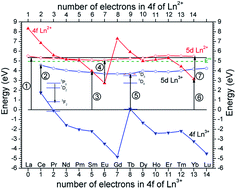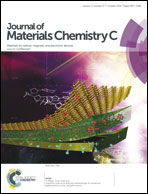Photoluminescence properties of Pr3+, Sm3+ and Tb3+ doped SrAlSi4N7 and energy level locations of rare-earth ions in SrAlSi4N7
Abstract
RE3+ (RE = Pr, Sm, and Tb)-doped SrAlSi4N7 samples were synthesized by a solid-state reaction method at high temperature, and their photoluminescence properties were investigated. It is noticeable that the 5d bands of Pr3+ and Tb3+ are at rather low energy in SrAlSi4N7 compared to oxides. Typical 4f2 → 4f2 emission lines (480–800 nm) of Pr3+ under 4f2 → 4f15d1 excitation were observed in Pr3+-doped SrAlSi4N7. Sm3+-doped SrAlSi4N7 shows red emission originating from 4G5/2 → 6HJ (J = 5/2, 7/2 and 9/2) transitions, and the charge transfer band of Sm3+ was observed at an unusually low energy of 3.98 eV. The Tb3+-doped sample exhibits 5D3 → 7FJ (J = 6, 5, 4, 3, 2, 1) (blue) and 5D4 → 7FJ (J = 6, 5, 4, 3) (green) line emissions in the wavelength range of 375–650 nm under the direct Tb3+ 4f8 → 4f75d1 excitation. The bands at about 256 nm in the excitation spectra are attributed to the host lattice absorption. In addition, there is energy transfer from the host lattice to the luminescent activators (Pr3+, Sm3+, and Tb3+). The energy level diagram containing the position of the 4f and 5d levels of all divalent and trivalent lanthanide ions relative to the valence and conduction band of SrAlSi4N7 has been constructed and discussed.


 Please wait while we load your content...
Please wait while we load your content...